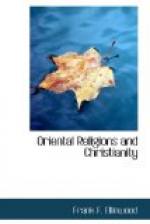The legends of Buddhism are a very different thing from the brief sketch which I have given, and which is based upon the earlier Buddhist literature. These sprang up after Gautama’s death, and their growth extended through many centuries—many centuries even of the Christian era. The legends divide the life of the Buddha into three periods: 1. That of his pre-existent states. 2. That part of his life which extended from his birth to his enlightenment under the Bo-tree. 3. The forty-five years of his Buddhaship. The legends have no more difficulty in dealing with the particular experiences of the pre-existent states than in enriching and adorning the incidents of his earthly life; and both are doubtless about equally authentic.
Gautama discarded the idea of a divine revelation; he rejected the authority of the Vedas totally. He denied that he was divine, but distinctly claimed to be a plain and earnest man. All that he knew, he had discovered by insight and self-conquest. To assume that he was pre-existently divine and omniscient subverts the whole theory of his so-called “discovery,” and is at variance with the idea of a personal conquest. The chief emphasis and force of his teachings lay in the assumption that he did simply what other men might do; for his mission was that of a teacher and exempler merely. He was a saviour only in that he taught men how to save themselves.
The pre-existent states are set forth in the “Jatakas,” or Birth Stories of Ceylon, which represent him as having been born five hundred and thirty times after he became a Bodisat (a predestined Buddha). As a specimen of his varied experience while becoming fitted for Buddaship, we read that he was born eighty-three times as an ascetic, fifty-eight as a monarch, forty-three as a deva, twenty-four as a Brahman, eighteen as an ape; as a deer ten, an elephant six, a lion ten; at least once each as a thief, a gambler, a frog, a hare, a snipe. He was also embodied in a tree. But as a Bodisat he could not be born in hell, nor as vermin, nor as a woman! Says Spence Hardy, with a touch of irony: “He could descend no lower than a snipe.”
Northern legends represent Buddha as having “incarnated” for the purpose of bringing relief to a distressed world. He was miraculously conceived—his mother’s side in the form of a white elephant. All nature manifested its joy on the occasion. The ocean bloomed with flowers; all beings from many worlds showed their wonder and sympathy. Many miracles were wrought even during his childhood, and every part of his career was filled with marvels. At his temptation under the Bo-tree, Mara (Satan) came to him mounted on an elephant sixteen miles high and surrounded by an encircling army of demons eleven miles deep.[81] Finding him proof against his blandishments, he hurled mountains of rocks against him, and assailed him with fire and smoke and ashes and filth—all of which became as zephyrs on his cheek or as presents of fragrant flowers. Last of all, he sent his three daughters to seduce him. Their blandishments are set forth at great length in the “Romantic Legend.”




